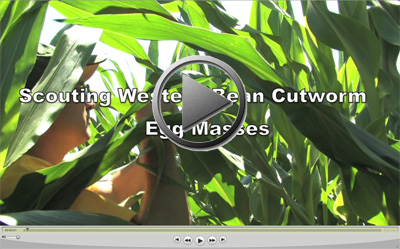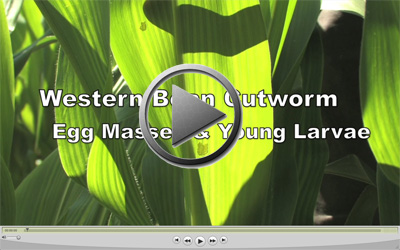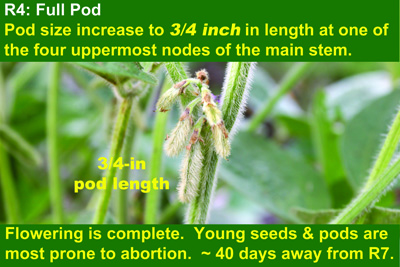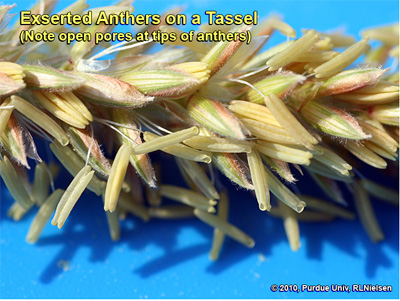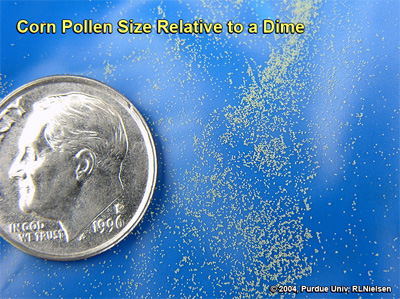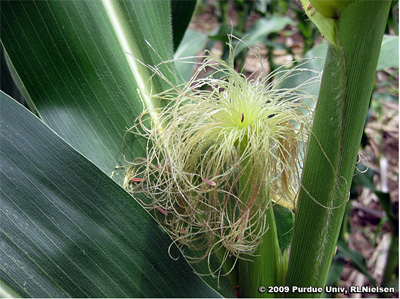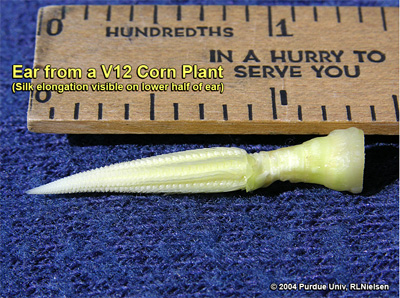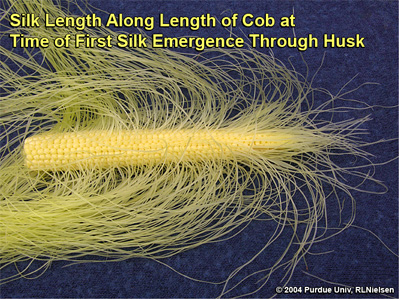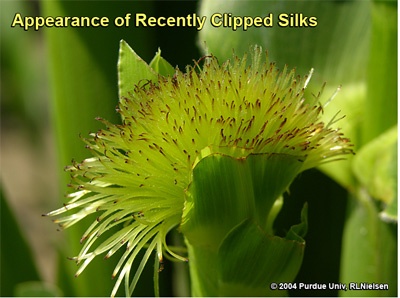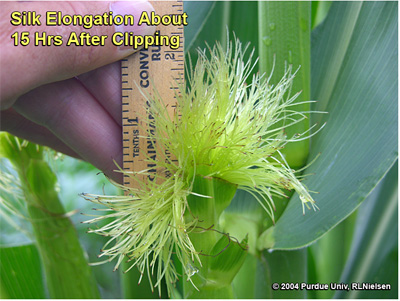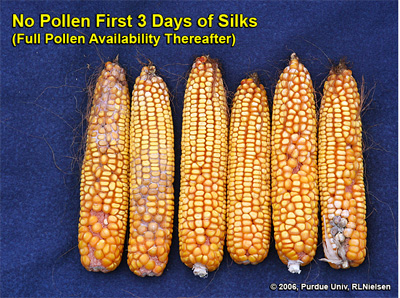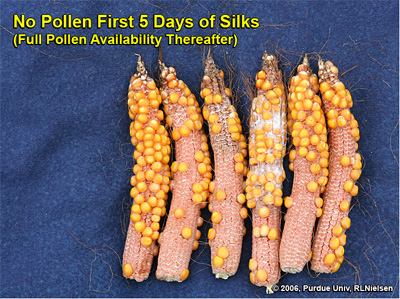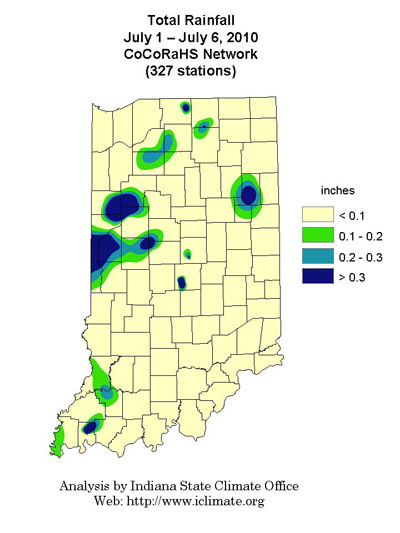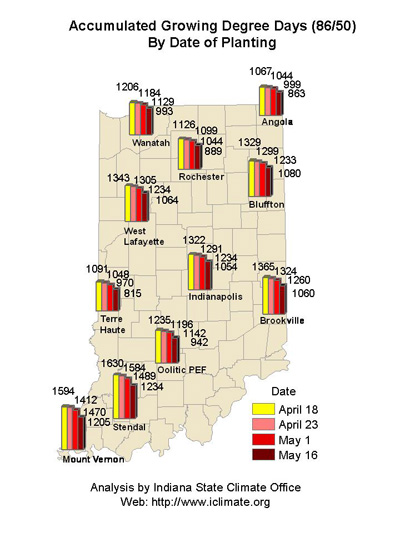Pest & Crop Newsletter, Entomology Extension, Purdue University
- Black Light Trap Catch Report
- Western Bean Cutworm Adult Catch Trap Report
- VIDEO: Western Bean Cutworm Early Scouting
- VIDEO: Western Bean Cutworm Eggs and Hatching Larvae
- Soybean Early Reproductive Growth Stages
- Tassel Emergence & Pollen Shed
- Silk Development and Emergence in Corn
Click here to view the Black Light Trap Catch Report
![]()
Click here to view the Western Bean Cutworm Adult Pheromone Trap Report
![]()
VIDEO: Western Bean Cutworm Early Scouting - (Christian Krupke and John Obermeyer) - This video describes proper scouting procedures for western bean cutworm egg masses in corn and treatment considerations
View this video on Western Bean Cutworm Early Scouting
![]()
VIDEO: Western Bean Cutworm Eggs and Hatching Larvae - (Christian Krupke and John Obermeyer) - The following video shows three stages of the western bean cutworm egg masses, describes how to find them on corn, and where hatching larvae go and their early feeding.
View this video on Western Bean Cutworm Egg Masses and Young Larvae
VIDEO: Corn Diseases and Hot, Humid Conditions in July – (Kiersten Wise)
This video shows and describes three corn leaf diseases. During current hot, humid conditions, gray leaf spot is becoming common in many cornfields.
View this video on Corn Diseases and Hot, Humid Conditions in July
Viw this video on Corn Diseases and Hot, Humid Conditions in July
![]()
Fungicide Applications to Manage Corn Diseases – (Kiersten Wise)
Gray leaf spot has been confirmed in many corn fields across Indiana. Disease severity varies throughout fields, but high levels of the disease have been observed in some fields, especially on hybrids rated as susceptible for gray leaf spot. Northern corn leaf blight and common rust can also be found in fields. The warm, humid weather over the last few weeks has created perfect conditions for disease development, and the heavy dews and intermediate rains we have received have also contributed to increased disease severity. For more information about conditions that favor gray leaf spot, please see a previous article in the June 25th edition of the Pest&Crop Newsletter: <http://extension.entm.purdue.edu/pestcrop/2010/issue13/index.html#conditions>.
Many producers are interested in spraying fungicides at this time, and are considering lining up applications to fields to prevent yield loss due to disease. Yield loss may depend on the number of lesions and how far up in the canopy they occur as the plant enters tasseling and pollination. If lesions have reached the ear leaf or higher during the two weeks before and after tasseling, yield loss could occur. If lesions develop on upper leaves later in the season, the economic impact will be less.
The decision on whether or not to apply a fungicide seems like a straightforward question, but not every corn field in Indiana may need a fungicide application to manage gray leaf spot in 2010. It is also important to remember that a fungicide application is an additional cost to corn production, and growers must consider economic factors (corn market price, and fungicide application cost) and other disease factors before deciding whether to apply a fungicide for gray leaf spot management.
Research in Indiana indicates that strobilurin and strobilurin/triazole premix fungicides are most effective at preventing yield loss when applied in response to disease presence, and at the tasseling to early silking (VT-R1) growth stage.
One important point to note is that university researchers have not seen consistent yield benefits from foliar fungicide applications in corn. In other words, we see a lot of variation in the yield response from a fungicide application, and a foliar fungicide application has not been profitable in every situation. This said, we know that there are certain factors that influence disease development and understanding these factors can aid in making a decision on whether or not to apply a fungicide:
1. Hybrid susceptibility. Hybrids vary in their susceptibility to foliar diseases of corn, and hybrids susceptible to diseases such as gray leaf spot are at a greater risk of disease development than hybrids with moderate or high levels of disease resistance.
2. Previous crop and cropping system. Most of the fungal diseases, such as gray leaf spot, survive from year to year on crop residue, and planting corn-on-corn, and planting corn into high levels of corn residue (no-till) will increase the likelihood that disease will develop.
3. Late planting. Research from Iowa State University has demonstrated that late-planted corn is at higher risk of gray leaf spot development.
4. Favorable weather conditions. Foliar diseases, like gray leaf spot, require high humidity, moisture and moderate to warm temperatures for disease development.
These points have been outlined in past Pest&Crop Newsletters, and also by many other university researchers around the Midwest, however, gray leaf spot severity can be unpredictable in Indiana, even when factors favoring disease are present. Therefore, consider all factors, including economic factors, when deciding whether to use a fungicide to manage gray leaf spot.
A final point is that some level of disease can be found in almost every field at this point in time, but the decision to spray should be based on the type of disease present, as well as the factors discussed above. For instance, we have seen many fields with common rust, and as rust pustules age and dry down, they are easily confused with gray leaf spot. Common rust rarely causes serious yield loss, and a few lesions of common rust on a leaf will not justify a fungicide application.
Soybean Early Reproductive Growth Stages – (Shaun Casteel)
Soybean development in Indiana ranges from just planted to flowering and podding. As of the 4th of July, 96% of the soybeans had emerged and 23% were blooming. Management decisions are based on the growth stage, the time of the year, and pest (weeds, insects, disease) occurrence. We will overview the early reproductive stages of soybean for proper scouting.
Reproductive Growth Stages:
R1 – Beginning Bloom is defined as any open flower(s) on any of the main stem nodes. Flowering normally begins at the third to sixth main stem node (including the cotyledon and unifoliate nodes). A node is the point where the lateral leaf branch attaches to the main stem. It will form a bump, which is helpful in determining the nodes of the cotyledons and the unifoliates. Cotyledons and unifoliates eventually abscise as vegetative growth progresses up the plant. These nodes will have a bump on opposite sides of the stem followed by alternating nodes of the trifoliates (see R1 picture). Flowering begins around six to eight weeks after emergence and it is both temperature and photoperiod responsive. Vertical root growth rate increases rapidly. Approximately 65 days away from the beginning of physiological maturity (R7).
The soybean pictured to the right is R1 with six trifoliates. The first flower was initiated at trifoliate node 2, which is node 4 when cotyledon and unifoliate nodes are included. This plant would be classified as V6 (vegetative stage 6) if there was no open flowers on the main stem.
R1: Beginning Bloom
R2 – Full Bloom is where any open flower is located at one of the two uppermost nodes of the main stem. Plant has accumulated ~25% of the total dry weight and ~50% of the total node number. Rapid dry weight and nutrient accumulation begins and continues until physiological maturity. Nitrogen fixation rate increases as does the plant’s nitrogen demand. Approximately 60 days away from the beginning of physiological maturity (R7).
R2: Full Bloom
R3: Beginning Pod
R4: Full Pod
| Growth Stage | Duration Median | Duration Range |
|---|---|---|
| # of Days | ||
| R1: Beginning Bloom | 4 | 1 to 7 |
| R2: Full Bloom | 10 | 5 to 15 |
| R3: Beginning Pod | 10 | 5 to 15 |
| R4: Full Pod | 10 | 4 to 26 |
| R5: Beginning Seed | 15 | 11 to 20 |
| R6: Full Seed | 20 | 9 to 30 |
![]()
Tassel Emergence & Pollen Shed – (Bob Nielsen)
- Corn produces individual male and female flowers on the same plant.
- The tassel represents the male flower of the corn plant.
Depending on the year, Indiana’s corn crop typically enters the critical flowering stages of pollen shed and silk emergence sometime between late June to late July. Success or failure during this period of the corn plant’s life greatly influences the potential grain yield at harvest time.
As important as this process is to the determination of grain yield, it is surprising how little some folks know about the whole thing. Rather than leaving you to learn about such things “in the streets”, I’ve developed this article and the accompanying one on silking (Nielsen, 2010) that describe the ins and outs of sex in the corn field.
Remember that corn has both male flowers and female flowers on the same plant (a flowering habit called monoecious for you trivia fans.) Interestingly, both flowers are initially bisexual (aka “perfect”), but during the course of development the female components (gynoecia) of the male flowers and the male components (stamens) of the female flowers abort, resulting in tassel (male) and ear (female) development.
Field of tasseling corn
Anther exsertion beginning on central tassel branch
Growth Stage VT (Tasseling)
Portions of the tassel may be visible before the plant technically reaches the last leaf stage (final visible leaf collar) has occurred. By definition, growth stage VT occurs when the last branch of the tassel emerges from the whorl (Ritchie et. al., 1993). This authoritative source furthermore stated that growth stage VT is “initiated when the last branch of the tassel is completely visible and the silks have not yet emerged.” Once upon a time, that exact developmental sequence may have been true, but today’s hybrids tend to behave differently. It is not uncommon for silk emergence to begin not only prior to the last tassel branch appearing from the whorl, but also prior to the exsertion of anthers and pollen shed (Nielsen, 2009).
Plant height reaches its maximum at or shortly after growth stage VT as the final stalk internodes complete their elongation. The corn plant is most vulnerable to hail damage at growth stage VT because all of its leaves are exposed. Complete (100%) leaf loss at growth stage VT will usually result in complete (100%) yield loss by harvest. Even if pollination results in successful fertilization of the ovules, entire ear shoots will usually die because so few leaves remain to produce the necessary carbohydrates (by photosynthesis) to complete grain fill.
Full anther exsertion throughout all tassel branches
Exserted anthers on a tassel
CLoseup of anthers
Tassel Morphology
Approximately 1,000 individual spikelets form on each tassel and each one bears two florets encased in two large glumes. Each floret contains three anthers. An anther and its attached filament comprise the stamen of the male flower. The anthers are those “thingamajigs” that hang from the tassel during pollination. Under a magnifying lens, anthers look somewhat like the double barrel of a shotgun. Do the math and you will realize that an individual tassel produces approximately 6,000 pollen-bearing anthers, although hybrids can vary greatly for this number.
As these florets mature, elongation of the filaments helps exsert the anthers from the glumes. Pollen is dispersed through pores that open at the tips of the anthers. Pollen shed usually begins in the mid-portion of the central tassel spike and then progresses upward, downward and outward over time. Anthers typically emerge from the upper floret of the pair first, while those from lower floret typically emerge later the same day or on following days. Spent anthers eventually drop from the tassel and are sometimes mistaken for the pollen when observed on the leaves or ground.
The yellow or white “dust-like” pollen that falls from a tassel represents millions of individual, nearly microscopic, spherical, yellowish- or whitish translucent pollen grains. Estimates of the total number of pollen grains produced per tassel range from 2 to 25 million. Each pollen grain contains the male genetic material necessary for fertilizing the ovary of one potential kernel.
Corn pollen size relative to a dime
The outer membrane of a pollen grain is very thin. Once dispersed into the atmosphere, pollen grains remain viable for only a few minutes before they desiccate. Yet, with only a 15 mph wind, pollen grains can travel as far as 1/2 mile within those couple of minutes.
Therein lies the concern of the potential for pollen “drift” from a transgenic corn field to an adjacent non-transgenic corn field and the risk of transgenic “contamination” of grain intended for non-transgenic markets. The good news is that recent research suggests that the overwhelming majority of a corn field’s pollen load is shed in the field itself.
All of the pollen from a single anther may be released in as little as three minutes. All the anthers on an individual tassel may take as long as seven days to finish shedding pollen, although the greatest volume of pollen is typically shed during the second and third day of anther emergence. Because of natural field variability in plant development, a whole field may take as long as 14 days to complete pollen shed.
Peak pollen shed usually occurs in mid-morning. Some research indicates that pollen shed decreases after temperatures surpass 86°F. A second “flush” of pollen often occurs in late afternoon or evening as temperatures cool. Pollen shed may occur throughout most of the day under relatively cool, cloudy conditions.
Weather conditions influence pollen shed. If the anthers are wet, the pores will not open and pollen will not be released. Thus, on an average Indiana summer morning following a heavy evening dew, pollen shed will not begin until the dew dries and the anther pores open. Similarly, pollen is not shed during rainy conditions. Cool, humid temperatures delay pollen shed, while hot, dry conditions hasten pollen shed.
Extreme heat stress (100°F or greater) can kill corn pollen, but fortunately the plant avoids significant pollen loss by virtue of two developmental characteristics. First of all, corn pollen does not mature or shed all at once. Pollen maturity and shed occur over several days and up to two weeks. Therefore, a day or two of extreme heat usually does not affect the entire pollen supply. More importantly, the majority of daily pollen shed occurs in the morning hours when air temperature is much more moderate.
Related Reading
Kling, Jennifer G. and Gregory Edmeades. 1997. Morphology and growth of maize. IITA/CIMMYT Research Guide 9. Int’l Institute of Tropical Agriculture. [On-Line}. Available at <http://www.iita.org/cms/details/trn_mat/irg9/irg9.htm> [URL accessed July 2010].
Nielsen, RL (Bob). 2007. A Fast & Accurate Pregnancy Test for Corn. Corny News Network, Purdue Univ. [On-Line]. Available at <http://www.kingcorn.org/news/timeless/EarShake.html>[URL accessed July 2010].
Nielsen, RL (Bob). 2009. Unusually long silks in corn. Corny News Network, Purdue Univ. [online] <http://www.kingcorn.org/news/timeless/LongSilks.html> [URL accessed July 2010].
Nielsen, RL (Bob). 2010. Silk Emergence. Corny News Network, Purdue Univ. [On-Line]. Available at <http://www.kingcorn.org/news/timeless/Silks.html> [URL accessed July 2010].
Ritchie, S.W., J.J. Hanway, and G.O. Benson. 1993. How a Corn Plant Develops. Iowa State Univ. Sp. Rpt. No. 48. [On-Line]. Available at <http://www.extension.iastate.edu/hancock/info/corn.htm> [URL accessed July 2010].
Russell, W.A. and A.R. Hallauer. 1980. Corn. (a chapter in) Hybridization of Crop Plants. American Soc. of Agronomy-Crop Science Soc. of America. Madison, WI.
![]()
Silk Development and Emergence in Corn – (Bob Nielsen)
- Corn produces individual male and female flowers on the same plant.
- The ear represents the female flower of the corn plant.
- Severe soil moisture deficits can delay silk emergence and disrupt the synchrony of pollen shed and silk availability, resulting in poor kernel set.
The corn plant produces individual male and female flowers (a flowering habit called monoecious for you corny trivia fans.) Interestingly, both flowers are initially bisexual (aka “perfect”), but during the course of development the female components (gynoecia) of the male flowers and the male components (stamens) of the female flowers abort, resulting in tassel (male) and ear (female) development.
The silks that emerge from the ear shoot are the functional stigmas of the female flowers of a corn plant. Each silk connects to an individual ovule (potential kernel). A given silk must be pollinated in order for the ovule to be fertilized and develop into a kernel. Up to 1000 ovules typically form per ear, even though we typically harvest only 400 to 600 actual kernels per ear.
Technically, growth stage R1 (Ritchie et. al., 1993) for a given ear is defined when a single silk strand is visible from the tip of the husk. A field is defined as being at growth stage R1 when silks have emerged on at least 50 % of the plants.
Silk emergence on an ear of corn
Silk Elongation and Emergence
Silks begin to elongate from the ovules 10 to 14 days prior to growth stage R1 or approximately at the V12 leaf stage. Silk elongation begins first from the basal ovules of the cob, then proceeds sequentially up the ear. Because of this acropetal sequence of silk elongation, silks from the basal (butt) portion of the ear typically emerge first from the husk, while the tip silks generally emerge last. Complete silk emergence from an ear generally occurs within four to eight days after the first silks emerge from the husk leaves.
As silks first emerge from the husk, they lengthen as much as 1.5 inches per day for the first day or two, but gradually slow over the next several days. Silk elongation occurs by expansion of existing cells, so elongation rate slows as more and more cells reach maximum size. Elongation of an individual silk stops shortly after pollen is captured, germinates and then penetrates the silk.
Silk elongation on the lower half of a V12 ear shoot; 10 to 14 days before silk emergence
Variable silk length along length of cob at first silk emergence; illustrating the acropetal development of silks
If not pollinated, silk elongation stops about 10 days after silk emergence due to senescence of the silk tissue. Unusually long silks can be a diagnostic symptom that the ear was not successfully pollinated.
Silks remain receptive to pollen grain germination up to 10 days after silk emergence, but to an ever-decreasing degree. The majority of successful ovule fertilization occurs during the first 4 to 5 days after silk emergence (see photos that follow).
Natural senescence of silk tissue over time results in collapsed tissue that restricts continued growth of the pollen tube. Silk emergence usually occurs in close synchrony with pollen shed, so that duration of silk receptivity is normally not a concern. Failure of silks to emerge in the first place, however, does not bode well for successful pollination.
Appearance of silks recently clipped using knife; note the damaged, non-receptive ends of the clipped silksAbout 1.5 inches of silk elongation since being manually clipped about 15 hrs previous
About 1.5 inches of silk elongation since being manually clipped about 15 hrs previous
Pollination and Fertilization
For those of you serious about semantics, let’s review two definitions relevant to sex in the cornfield. Pollination is the act of transferring the pollen grains to the silks by wind or insects. Fertilization is the union of the male gametes from the pollen with the female gametes from the ovule. Technically, pollination is almost always successful (i.e., the pollen reaches the silks), but unsuccessful fertilization (i.e., pollen tube failure, silk failure, pollen death) will fail to result in a kernel.
Pollen "captured" by silk trichomes on a popcorn hybrid with anthocyanin-pigmented silks
Pollen grain germination occurs within minutes after a pollen grain lands on a receptive silk. A pollen tube, containing the male genetic material, develops and grows inside the silk, and fertilizes the ovule within 24 hours. Pollen grains can land and germinate anywhere along the length of an exposed receptive silk. Many pollen grains may germinate on a receptive silk, but typically only one will successfully fertilize the ovule.
Kernel set on ears where pollination was prevented for 3 days after first silk emergence then allowed to proceed without intereference
Silk Emergence Failure
Severe Drought Stress. The most common cause of incomplete silk emergence is severe drought stress. Silks have the greatest water content of any corn plant tissue and thus are most sensitive to moisture levels in the plant. Severe moisture deficits will slow silk elongation, causing a delay or failure of silks to emerge from the ear shoot. If the delay is long enough, pollen shed may be almost or completely finished before receptive silks are available; resulting in nearly blank or totally blank cobs. Severe drought stress accompanied by low relative humidity can also desiccate exposed silks and render them non-receptive to pollen germination.
The severity of drought stress required for significant silk emergence delay or desiccation can probably be characterized by severe leaf rolling that begins early in the morning and continues into the early evening hours. Such severe leaf rolling is often accompanied by a change in leaf color from “healthy” green to a grayish-tinged green that may eventually die and bleach to a straw color.
Silk Clipping by Insects. Although technically not described as silk emergence failure, severe silk clipping by insects such as corn rootworm beetle or Japanese beetle nonetheless can interfere with the success of pollination by decreasing or eliminating viable or receptive exposed silk tissue. Fortunately, unless the beetle activity is nonstop for days, continued elongation of silks from the husk will expose undamaged and receptive silk tissue at the rate of about one inch or more per day.
Kernel set on ears where pollination was prevented for 4 days after first silk emergence, then allowed to proceed without interference
Kernel set on ears where pollination was prevented for 5 days after first silk emergence, then allowed to proceed without intereference
Related Reading
Kling, Jennifer G. and Gregory Edmeades. 1997. Morphology and growth of maize. IITA/CIMMYT Research Guide 9. Int’l Institute of Tropical Agriculture. [On-Line}. Available at <http://www.iita.org/cms/details/trn_mat/irg9/irg9.htm> [URL accessed July 2010].
Nielsen, R.L. (Bob). 2007. A Fast & Accurate Pregnancy Test for Corn. Corny News Network, Purdue Univ. [On-Line]. Available at <http://www.kingcorn.org/news/timeless/EarShake.html> [URL accessed July 2010].
Nielsen, R.L. (Bob). 2010. Tassel Emergence & Pollen Shed. Corny News Network, Purdue Univ. [On-Line]. Available at <http://www.kingcorn.org/news/timeless/Tassels.html> [URL accessed July 2010].
Purdue Univ. 2010. Corn Rootworms. Entomology Dept, Purdue Univ. [online] <http://extension.entm.purdue.edu/fieldcropsipm/insects/corn-rootworms.php> [URL accessed July 2010].
Ritchie, S.W., J.J. Hanway, and G.O. Benson. 1993. How a Corn Plant Develops. Iowa State Univ. Sp. Rpt. No. 48. [On-Line] Available at <http://www.extension.iastate.edu/hancock/info/corn.htm> [URL accessed July 2010].
Russell, W.A. and A.R. Hallauer. 1980. Corn. (a chapter in) Hybridization of Crop Plants. American Soc. of Agronomy-Crop Science Soc. of America. Madison, WI.
Steffey, Kevin. 2005. Rootworm Adults and Silk Clipping. Pest & Crop Bulletin, Univ. of Illinois. [On-Line]. Available at <http://bulletin.ipm.illinois.edu/article.php?id=352> [URL accessed July 2010].

